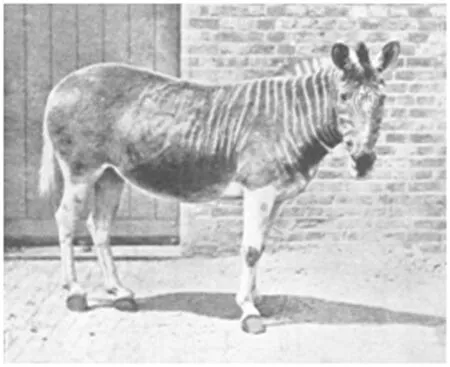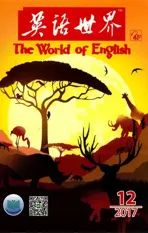5 Animals That Have Gone Extinct in the Past 50 Years 五十年来灭绝的五种动物
2018-01-06詹姆斯艾尔曹月审订仲文明ByJamesAyre
文/詹姆斯·艾尔 译/曹月 审订/仲文明 By James Ayre
5 Animals That Have Gone Extinct in the Past 50 Years 五十年来灭绝的五种动物
文/詹姆斯·艾尔 译/曹月 审订/仲文明 By James Ayre
The rise of industrial civilization over the last few hundred years has been accompanied by the extinction of a truly vast number of different animals (as well as plant, fungi, etc.) species. While going over all such extinctions would be an impossible thing to do in a single article,it’s probably worth highlighting some of the extinctions here in order to bring more eyes to the issue.
[2] I’m going to focus here on some of the more charismatic1charismatic有超凡魅力的。(to the eyes of a human) and immediately recognizable of the animal species that have gone in extinct in recent times. With that said, here are 5 animals that have gone extinct in the past 50 years:
Baiji River Dolphin
[3] Owing to protocol, the Baiji River Dolphin (Lipotesvexillifer) has yet to actually be declared as being extinct—but, for all intents and purposes, the animal species is now long gone.
近几百年来,工业文明蓬勃发展,随之而来的却是物种(动物、植物和真菌等)的大量灭绝。限于篇幅,本文无法一一列举灭绝的物种,只能着重介绍以下几种动物,以期得到更多人对这个问题的关注。
[2]我将从近年来灭绝的物种中,选择几种(在人类看来)较有魅力且较为熟悉的动物重点介绍,亦即下文将谈到的50年来灭绝的5种动物。

白鳍豚
[3]根据科研规程,白鳍豚(拉丁学名Lipotesvexillifer)尚未被正式宣布灭绝,但是不论如何,该物种已绝迹很久。
[4] The Baiji River Dolphin was a species of freshwater river dolphin native only to the Yangtze River in China. The animal has been “functionally extinct” since at least 2006, when a scientific population survey turned up no survivors.
[5] The species was once fairly prevalent, with up to 6000 individuals thought to live in the river system during the 1950s. Owing to industrialization,commercial fishing, and hydroelectric dams, though, this number fell dramatically in only a few decades.Leaving only a few hundred individuals alive by the 1980s. The last time one was seen was in 2004, though there was a possible sighting in 2007.
[4]白鳍豚属淡水豚类,仅生存于中国长江流域。至少在2006年后,种群数量调查再没有发现一头白鳍豚的身影。该物种已告“功能性灭绝”。
[5]白鳍豚种群数量一度比较可观,据估计,20世纪50年代长江流域中至少有6000头。然而,由于工业开发、商业捕捞以及水电大坝的修建,短短数十年间,白鳍豚种群数量急剧下降。20世纪80年代仅余数百头。最后一次发现白鳍豚是在2004年,但2007年有发现疑似白鳍豚的动物。
[6] Considering that the species (and/or closely related ones) has been around for literally tens of millions of years,the rapid destruction of population numbers due to industrial activity represents quite a remarkable event.It really drives home the point of just how environmentally and ecologically destructive modern industrial activity has been. And, for that matter, will continue to be as the arc that began several centuries ago continues to complete itself—and the last industrially useful (economically speaking) fuels become increasingly scarce, bringing about the intensifying exploitation of still remaining resources.

[6]白鳍豚(及/或相近物种)已在地球上生活长达数千万年之久,而工业活动导致其种群数量快速减少,这不能不引起我们的注意。同时,这一事件也深刻揭示了现代工业活动对环境和生态的毁灭性破坏。而且,几百年来,工业发展如渐张之弓,其势不可挡,目前仅剩的具有工业价值(就经济层面而言)的燃料日趋枯竭,加剧了对剩余资源的开发。
[7] The species was a fairly large one for a dolphin—measuring between 7.5—9 feet in length, and weighing up to 500 lbs. Lifespan in the wild was known to exceed 24 years. The Baiji River Dolphin could reach swimming speeds of up 37 miles per hour.
[8] Traditional stories of the region described the Baiji River dolphin as the reincarnation2reincarnation转世化身。of a princess who had been drowned by her family for refusing to marry a man that she did not love.
Western Black Rhinoceros
[9] The Western Black Rhinoceros was only just declared extinct by the IUCN3世界自然保护联盟(International Union for Conservation of Nature),简称IUCN,是世界上规模最大、历史最悠久的全球性非营利环保机构。总部位于瑞士格朗,亦可翻译为“国际自然与自然资源保护联盟”。in 2011. The species, which was quite genetically distinct from other rhino species, was once widespread throughout the savannas4savanna(东非等热带地区的)大草原,稀树草原。of sub-Saharan Africa.
[10] Hunting/poaching put an end to that though—and the population declined rapidly throughout the 20th century,from over a million individuals at the beginning of the century to… zero, now.Considering that the species emerged 7—8 million years ago, it had been doing pretty well—not well enough to deal with overexploitation by its competitors homo sapiens, though, apparently.
[7]豚类之中,白鳍豚的体型相对较大,长约7.5—9英尺,重达500磅。野生白鳍豚的寿命一般可超过24年,其游行速度可达每小时37英里。
[8]长江地区还有关于白鳍豚的传说。相传,一位公主因违背家族指令,拒绝嫁给不爱之人,惨遭溺死,死后化身为白鳍豚。
西部黑犀牛
[9] 2011年,国际自然保护联盟宣布西部黑犀牛灭绝。该物种与其他犀牛属种的基因极为不同,曾广泛分布于非洲撒哈拉沙漠以南的热带草原。
[10] 20世纪,黑犀牛的数量锐减,罪魁祸首是捕猎或偷猎。从20世纪初到现在,黑犀牛的数量已从100多万头降至为零。西部黑犀牛出现于约700万到800万年前, 一直生存得很好,却显然竞争不过过度捕猎的现代智人。
[11]有必要指出,在人类活动染指之前,多种犀牛类物种(如独角犀、板齿犀、披毛犀等)曾遍布世界各地。大家往往将犀牛种群数量的骤减归罪于非洲人,然而,分布在欧洲与北亚的犀牛也早就灭绝,因此所有人都难辞其咎。其实,只要有人类的地方,大型动物灭绝的背后或多或少都有人类的影子。有人好奇狮子为何在欧洲有着重要的象征意义,他们应该知道,狮子曾遍布欧洲各地,于罗马时期灭绝。给狮子种群造成致命一击的,正是罗马帝国后期对狮子毛皮的大量需求。
[11] It’s probably worth making a reminder here that various rhinoceroses species (the unicorn, Elasmotherium;woolly rhinos; etc.) were until recent human activity found throughout much of the world. While it’s easy to condemn people living in Africa now for the decline of the species,considering the fact that Europe and Northern Asia’s rhinos are long gone, no one is exempt from blame there. Megafauna5magafauna巨型动物。extinctions have accompanied people more or less wherever they’ve lived. On that note,those who have always wondered why lions figure so prominently in European symbolism6欧洲许多国家的国徽或国旗上都有狮子的形象,另外,狮子雕像在欧洲也随处可见。should probably recall the fact that the European lion only just went extinct during Roman times—the species, at one point, had been found all throughout Europe. The final push over the cliff for the species appears to have been the high demand for lion pelts7pelt毛皮。during the late roman period.
Pyrenean Ibex
[12] The Pyrenean Ibex was a species of Ibex native to the Iberian Peninsula in Europe that went extinct in 2000.The species had been quite common in Southern Europe up until the 19th century. The causes of extinction are thought to be over hunting and the loss of habitat to livestock. It’s possible that diseases introduced by domesticated animals played a part as well though.

比利牛斯野山羊
[12]比利牛斯野山羊原产于欧洲伊比利亚半岛,灭绝于2000年。19世纪以前,该物种曾一度遍布南欧。其消亡的原因可能是过度狩猎和被家畜占据栖息地,感染了家畜携带的疾病可能是部分原因。
Golden Toad
[13] The Golden Toad was a small,sort of golden-colored toad that was native to Costa Rica. It was only“discovered” just in 1966, before then being declared extinct by the IUCN in 2004, after a few decades of essentially no sightings. As most toads in the same family as the Golden Toad have lifespans at least as long as 12 years,though, perhaps there are still some hiding out somewhere?
[14] Factors in the toad’s presumed extinction include: restricted range,global warming, Chytridiomycosis, and airborne pollution.
Javan Tiger
[15] The Javan Tiger was a subspecies of tiger that was found only on the island of Java in Indonesia. It’s thought to have gone extinct in the middle of the 1970s—largely as the result of conflict with people (hunting, poisoning due to threats to livestock, and decreased prey) and deforestation + habitat loss(via expanding agriculture and human settlements).
金蟾蜍
[13]金蟾蜍个头较小,全身呈金黄色,生活于哥斯达黎加。金蟾蜍于1966年 才被首次发现。到2004年,由于几十年内未能发现其踪迹,世界自然保护联盟就宣告该物种灭绝。不过,金蟾蜍与蟾蜍科的其他动物一样,寿命可达12年,因此或许仍有部分金蟾蜍藏匿某处未被发现?
[14]一般认为,导致金蟾蜍消亡的原因有:栖息地狭小、全球变暖、壶菌疾病感染和空气污染。
爪哇虎
[15]爪哇虎属于虎的亚种,为印度尼西亚爪哇岛所特有。据信,20世纪70年代中期,爪哇虎就已经绝迹了,主要原因是与人类的冲突(因对家畜造成威胁被人猎杀或毒杀,以及猎物数量减少)、森林砍伐和栖息地丧失(由于扩展耕地和人类开发居住区)。
[16]值得注意的是,尽管数十年来目击爪哇虎的消息没有一条得到证实,此类传闻仍层出不穷,有趣的是,这些传闻明显地引起了当地居民的恐慌。数以百万计的人类占据了整座岛屿,力图掌控一切,却被可能存在的“危险”老虎吓得癫狂。并不是说老虎不危险,它们当然危险,有时还吃人,但我们反应的激烈程度总应该和面临的威胁大小成正比吧?人类真的有必要将其赶尽杀绝并霸占其栖息地吗?
[16] Worth noting, despite the fact that there hasn’t been a reliable sighting of the species in decades, rumors and supposed sightings persist—and, interestingly, these sighting still apparently trigger some panic in the people in the region. Tens of millions of people, covering the land from shore to shore, trying to control nearly everything, worked into a frenzy by the thought of one possible “dangerous”tiger being out there. That’s not to say that tigers aren’t dangerous, of course they are, they do eat people occasionally, but you’d hope that the scale of the threat would match with the scale of the response wouldn’t you? Did people really need to kill all the Javan tigers off, and take all of the tiger’s land/habitat from it?

(译者单位:中南大学)
10 Fascinating Extinct Animals (I)
1. Quagga班驴

The Quagga was a subspecies of the common plains zebra and a native of South Africa. Known for its unique stripes, the Quagga was hunted for its hide and killed by ranchers who believed the animals competed with livestock for grazing area, according to PBS.
The last known Quagga died at the Amsterdam Zoo in 1883.
